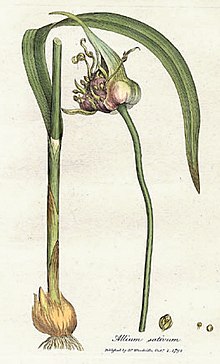Allium
| Allium | |
|---|---|
 |
|
| Allium sativum | |
| Scientific classification | |
| Kingdom: | Plantae |
| Clade: | Angiosperms |
| Clade: | Monocots |
| Order: | Asparagales |
| Family: | Amaryllidaceae |
| Subfamily: | Allioideae |
| Tribe: | Allieae |
| Genus: |
Allium L. |
| Type species | |
|
Allium sativum L. |
|
| Evolutionary lines | |
|
1–3: see text |
|
| Synonyms | |
|
Synonymy
|
|
1–3: see text
Allium is a genus of monocotyledonous flowering plants that includes the cultivated onion, garlic, scallion, shallot and leek as well as chives and hundreds of other wild species.
The generic name Allium is the Latin word for garlic, and Linnaeus first described the genus Allium in 1753. Some sources refer to Greek αλεω (aleo, to avoid) by reason of the smell of garlic. The cooking and consumption of parts of the plants is due to the large variety of flavours and textures of the species. Various Allium have been cultivated from the earliest times and about a dozen species are economically important as crops, or garden vegetables, and an increasing number of species are important as ornamental plants. The inclusion of a species to the genus Allium is taxonomically difficult and species boundaries are unclear. Estimates of the number of species have been as low as 260, and as high as 979, but are most likely about 800–850. The type species for the genus is Allium sativum.
Allium species occur in temperate climates of the Northern Hemisphere, except for a few species occurring in Chile (such as A. juncifolium), Brazil (A. sellovianum), and tropical Africa (A. spathaceum). They vary in height between 5 cm and 150 cm. The flowers form an umbel at the top of a leafless stalk. The bulbs vary in size between species, from small (around 2–3 mm in diameter) to rather large (8–10 cm). Some species (such as Welsh onion A. fistulosum) develop thickened leaf-bases rather than forming bulbs as such.
...
Wikipedia
